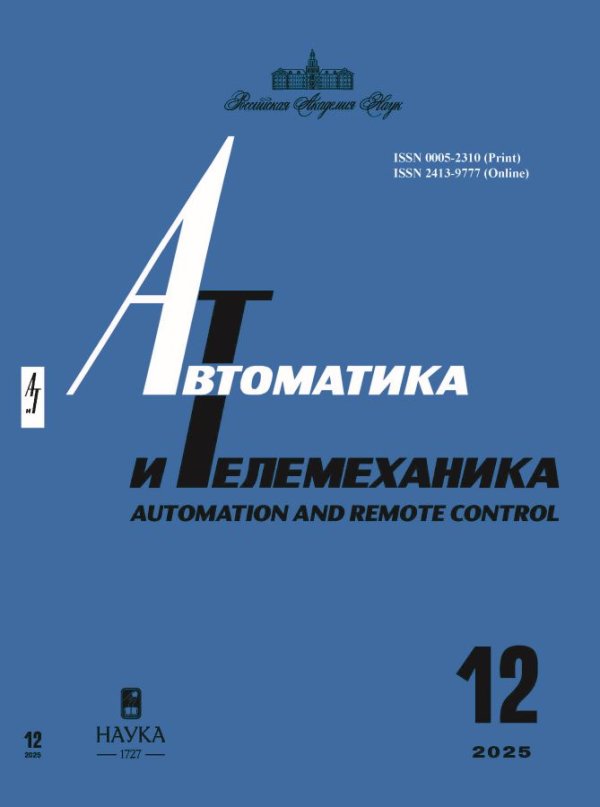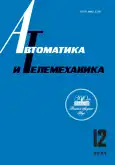Вероятностная оценка влияния состава пентапептида на его устойчивость
- Авторы: Михальский А.И1, Новосельцева Ж.А.1, Анашкина А.А2, Некрасов А.Н.3
-
Учреждения:
- Институт проблем управления им. В.А. Трапезникова РАН
- Институт молекулярной биологии им. В.А. Энгельгардта РАН
- Институт биоорганической химии им. академиков М.М. Шемякина и Ю.А. Овчинникова РАН
- Выпуск: № 12 (2023)
- Страницы: 38-48
- Раздел: Тематический выпуск
- URL: https://journals.rcsi.science/0005-2310/article/view/233431
- DOI: https://doi.org/10.31857/S0005231023120048
- EDN: https://elibrary.ru/NFXRAG
- ID: 233431
Цитировать
Полный текст
Аннотация
Изучается влияние расположения аминокислотных остатков в пентапептиде на его устойчивость. Cтроится прогноз устойчивости пентапептида с помощью метода градиентного бустинга, позволяющего оценить влияние каждого признака на стабильность пентапептида. Выявлены комбинации расположения аминокислот в пентапептиде, вносящие существенный вклад в его стабильность. Показано, что использование таких комбинаций позволяет сократить количество данных, необходимых для получения достоверного прогноза стабильности пентапептида.
Ключевые слова
Об авторах
А. И Михальский
Институт проблем управления им. В.А. Трапезникова РАН
Email: ipuran@yandex.ru
Москва
Ж. А. Новосельцева
Институт проблем управления им. В.А. Трапезникова РАН
Email: novoselc.janna@yandex.ru
Москва
А. А Анашкина
Институт молекулярной биологии им. В.А. Энгельгардта РАН
Email: a_anastasya@inbox.ru
Москва
А. Н. Некрасов
Институт биоорганической химии им. академиков М.М. Шемякина и Ю.А. Овчинникова РАН
Автор, ответственный за переписку.
Email: a_nnekrasov@mail.ru
Москва
Список литературы
- Senior A.W., Evans R., Jumper J. et al. Improved protein structure prediction using potentials from deep learning // Nature. 2020. V. 577. P. 706-710.
- Pereira J., Simpkin A.J., Hartmann M.D. et al. High accuracy protein structure prediction in CASP14 // Proteins Structure Function and Bioinformatics. 2021. V. 89. No. 12. P. 1687-1699. https://doi.org/10.1002/prot.26171
- Nekrasov A.N., Kozmin Yu.P., Kozyrev S.V. et al. Hierarchical structure of protein sequence // Int. J. Mol. Sci. 2021. V. 22. No. 15. 8339. https://doi.org/10.3390/ijms22158339
- Anashkina A.A., Nekrasov A.N., Alekseeva L.G. et al. A minimum set of stable blocks for rational design of polypeptide chains // Biochimie. 2019. V. 160. P. 88-92.
- Ke G., Meng Q., Finley T., Wang T. et al. A Highly Efficient Gradient Boosting Decision Tree // Proc. 31st Conference on Neural Information Processing Systems (NIPS). Long Beach. 2017. P. 3149-3157.
- Bergstra J., Yamins D., Cox D.D. Making a Science of Model Search: Hyperparameter Optimization in Hundreds of Dimensions for Vision Architectures // Proc. of the 30th International Conference on Machine Learning (ICML). 2013. P. 115-123.
- Lundberg S.M., Lee S.I. A unified approach to interpreting model predictions // Proc. 31st Conference on Neural Information Processing Systems (NIPS). Long Beach. 2017. P. 4765-4774.
- Mikhalskii A.I., Petrov I.V., Tsurko V.V., Anashkina A.A. et al. Application of mutual information estimation for prediction the structural stability of pentapeptides // Rus. J. Numer. Anal. Math. Model. 2020. V. 35. No. 5. P. 263-271.
Дополнительные файлы










